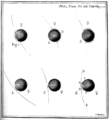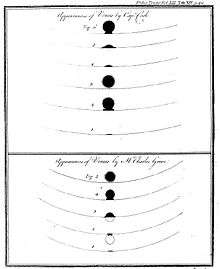Black drop effect

The black drop effect is an optical phenomenon visible during a transit of Venus and, to a lesser extent, a transit of Mercury.
Description
Just after second contact, and again just before third contact during the transit, a small black "teardrop" appears to connect Venus' disk to the limb of the Sun, making it impossible to time the exact moment of second or third contact accurately. This led to the failure of the attempts during the 18th century transits of Venus to establish a truly precise value for the astronomical unit.
The black drop effect was long thought to be due to Venus' thick atmosphere, and indeed it was held to be the first real evidence that Venus had an atmosphere. However, it is now thought by many to be an optical effect caused by the combination of the extreme darkening of the sun's disk near its apparent edge and the intrinsic imperfection of the viewing apparatus.[1][2]
Observing Mercury simultaneously during its transit in May 1832 with different instruments, Bessel and Argelander noticed a black drop effect (without then using this term) with that instrument of less resolution.[3] With precise measurements, a black drop effect was observed from outside the Earth's atmosphere during the 1999 and 2003 transits of Mercury, although Mercury has no significant atmosphere.[4]
In the 8 June 2004 transit of Venus, many observers reported that they did not see the black drop effect, or at least that it was much less pronounced than had been reported in earlier centuries' transits.[5] Larger telescopes, better optics, and limb darkening may have been factors.
Gallery
-

The black drop effect as depicted by Torbern Bergman in 1761.
-

The black drop effect as observed by Captain James Cook and Charles Green in 1771.
-

The black drop effect in 2004, in moments of "bad" seeing (left) and "good" seeing (right).
References
- ↑ Explanation of the Black-Drop Effect at Transits of Mercury and the Forthcoming Transit of Venus by Pasachoff/Schneider/Golub (Abstract). American Astronomical Society Meeting 203. Bulletin of the American Astronomical Society. 35. AAS. December 2003. p. 1202. Bibcode:2003AAS...203.0104P. Retrieved 2015-05-16.
- ↑ "Transits of Venus – Kiss of the goddess". The Economist. 27 May 2004. Retrieved 2015-05-16.
- ↑ F. W. Bessel: Durchgang des Mercurs durch die Sonne. In: Astronomische Nachrichten. Band X (1832), No. 228, Sp. 185–196 (digital).
- ↑ Schneider, G.; Pasachoff, J.M.; Golub, L. (2003). "Space Studies of the Black-Drop Effect at a Mercury Transit". arXiv:astro-ph/0310379
 . PrePrint or article in Icarus 168, 249-256. Retrieved 2015-05-16.
. PrePrint or article in Icarus 168, 249-256. Retrieved 2015-05-16. - ↑ Shiga, David (24 May 2012). "The Disappearing Black Drop". SkyandTelescope.com. F+W Meida, Inc. Retrieved 2015-05-16.
External links
| Wikimedia Commons has media related to Black drop effect. |
- The black drop effect
- The "Black Drop" effect—explanation at the TransitOfVenus.org website
- Sky and Telescope: The Disappearing Black Drop
- Video Simulating Black Drop effect using your hand